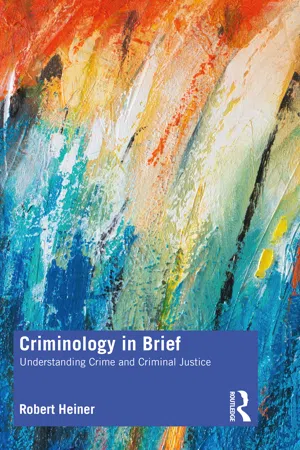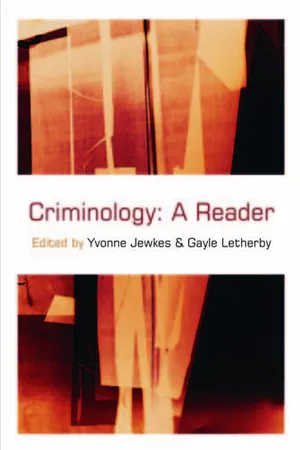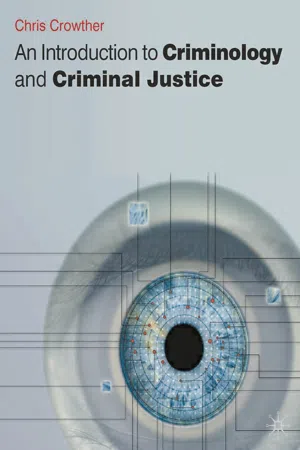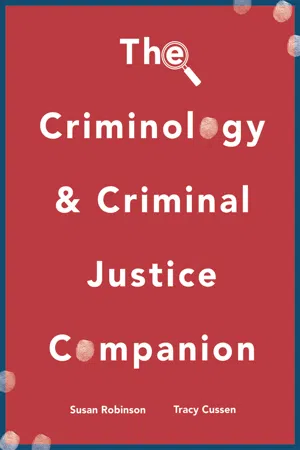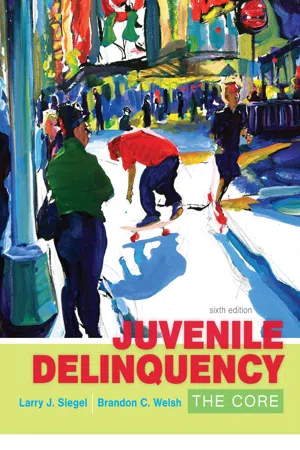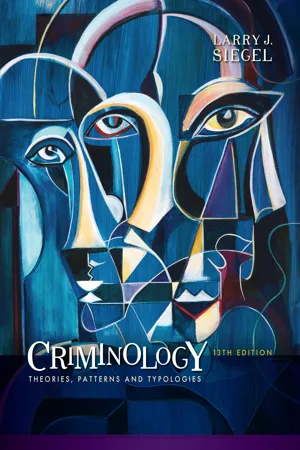Social Sciences
Sociological Theories of Crime
Sociological theories of crime seek to understand the social factors that contribute to criminal behavior. These theories explore how social structures, institutions, and interactions influence individuals' likelihood of engaging in criminal activities. They emphasize the role of socialization, inequality, and power dynamics in shaping criminal behavior within a given society.
Written by Perlego with AI-assistance
Related key terms
1 of 5
9 Key excerpts on "Sociological Theories of Crime"
- eBook - PDF
Sociology
The Essentials
- Margaret L. Andersen; Howard F. Taylor, Margaret Andersen, Howard Taylor(Authors)
- 2016(Publication Date)
- Cengage Learning EMEA(Publisher)
Each perspective traces criminal behavior to social condi-tions rather than only to the intrinsic tendencies or personalities of individuals. ◆ Table 7.2 Sociological Theories of Crime Functionalist Theory Symbolic Interaction Theory Conflict Theory Societies require a certain level of crime in order to clarify norms. Crime is behavior that is learned through social interaction. The lower the social class, the more the individual is forced into criminality. Crime results from social structural strains (such as class inequality) within society. Labeling criminals and stigmatizing them tends to reinforce rather than deter crime. Inequalities in society by race, class, gender, and other forces tend to produce criminal activity. Crime may be functional to society, thus difficult to eradicate. Institutions with the power to label, such as prisons, actually produce rather than lessen crime. Reducing social inequality in society is likely to reduce crime. © Cengage Learning Some deviance develops in deviant communities, such as the neo-Nazis/“skinheads” shown marching here. Such right-wing extremist groups have increased significantly in recent years, as monitored by the Southern Poverty Law Center. Jim West/Alamy Copyright 2017 Cengage Learning. All Rights Reserved. May not be copied, scanned, or duplicated, in whole or in part. Due to electronic rights, some third party content may be suppressed from the eBook and/or eChapter(s). Editorial review has deemed that any suppressed content does not materially affect the overall learning experience. Cengage Learning reserves the right to remove additional content at any time if subsequent rights restrictions require it. 160 CHAPTER 7 Measuring Crime: How Much Is There? Is crime increasing in the United States? One would cer-tainly think so from watching the media. Images of vio-lent crime abound and give the impression that crime is a constant threat and is on the rise. - eBook - ePub
Criminology in Brief
Understanding Crime and Criminal Justice
- Robert Heiner(Author)
- 2020(Publication Date)
- Routledge(Publisher)
CHAPTER 3Sociological Theories of Crime
Sociological thinking about crime
Biologists and psychologists typically think about crime on an individual level, asking how is the criminal different from the non-criminal? Sociologists, on the other hand, focus less on the individual and more on the environment, asking, how does the environment influence people’s behavior? In an over-simplification, it is often said that sociologists study groups. This is because the groups to which we belong determine the environments to which we are exposed. Here, the word “group” often refers to the demographic group to which we belong, for examples, our social class, race, age, gender, religion, and the neighborhood or region in which we live.With its focus on the group, sociologists are better able to explain aggregates, trends, and crime rates than are biologists and psychologists. For example, in the 1980s, it was estimated that there were 35 serial killers on the loose at any given time.1 Thirty-five is a very small number relative to a population of more than 300 million; and one might better turn to the psychologist rather than a sociologist for an explanation of why does someone become a serial murderer. On the other hand, there were over 16,000 homicides in the United States in 2018; and the sociologist is better equipped to handle such questions as why are murder rates so much higher in Chicago than in Seattle, or why are murder rates so much lower today than they were in 1990, or which demographic groups are more likely to commit murder and why.Sociologists are also concerned with societal reactions to crime. Criminal justice policies represent a set of societal reactions, as do the labeling of criminals, and public fears about crime. For example, while there were considerably fewer than 100 victims of serial murderers in any given year, in the 1980s, the FBI was reporting that there were many thousands of such victims; popular culture was inundated with accounts of serial killers; and the public’s awareness and fear of serial killers rose exponentially.2 So, while sociologists may not be so interested in why a person becomes a serial killer, they might be very concerned with why the FBI’s and the culture’s reaction to the phenomenon was so disproportionate to its actual incidence at that time (see Chapter 4 - eBook - PDF
Criminology
A Reader
- Yvonne Jewkes, Gayle Letherby, Yvonne Jewkes, Gayle Letherby(Authors)
- 2002(Publication Date)
- SAGE Publications Ltd(Publisher)
2 Perspectives in criminological theory Sandra Walklate The development of criminology has been characterized by influences from a vast and diverse range of competing theoretical perspectives. In the extract that follows, Sandra Walklate outlines some of the most prominent theories that have shaped modern criminology, arguing that they can be broadly divided into three main categories: a concern with the behaviour of criminals; a concern with the criminality of behaviour; and a concern with the criminality of the state. In the first category, she shows how the classical and positivist schools, although separated by over a century, set up some of the key debates that are still contested by criminologists today – not least the question of whether people freely and rationally choose to commit crime, or whether they are propelled into crime through circumstances beyond their control. As Walklate notes, this fundamental issue is not only crucial for understanding the causes of crime, but it is also of profound importance when considering our responses to crime, and implementing policy. Following her discussion of individualistic explanations for the behavi-our of criminals, Walklate goes on to consider some of the theoretical approaches that have sought social, or sociological, explanations for the criminality of behaviour, focusing on the theories of: social disorga-nization; ‘strain’; and labelling (the last of which is also represented by an extract from the original text by Howard S. Becker in Reading 3). Finally, in her analysis of theories that have directed attention to the criminality of the state, Walklate discusses some of the so-called ‘radi-cal’ criminologies: Marxism; the ‘new criminology’; and critical criminol-ogy, each of which extends and develops the thinking of its predecessor. - Chris Crowther-Dowey(Author)
- 2017(Publication Date)
- Red Globe Press(Publisher)
Perhaps the most important characteristic of the type of sociological explanations mentioned above is that they are not particularly concerned with the individual human subject. Rather they are interested in the organization and development of society as a whole. To apply this argument to crime, they are not interested in the indi-vidual criminal in separation from broader patterns of crime, delinquency and deviance. Moreover, the distribution of crime is explained in relation to wider social, economic and cultural structures. Many sociologists are interested in examining the changes occurring in these structures, and their bearing on the occurrence of crime, especially property offences. Many sociological accounts are influenced by a positivist understanding of human behaviour, of the kind outlined in the previous chapter. However, in contrast to Chapter 11, here we consider whether crime is caused by forces external to the individual, rather than the factors inherent to individuals such as their psychological or biological make-up. The positivist influence is also demonstrated by the commitment to investigating crime by drawing on a range of qualitative and quantitative methods (see Chapter 4). Perhaps the most influential concept in sociological variants of criminological theory, at least in the early days of the discipline, is anomie. 294 Theories of Crime Anomie As you may already know, Emile Durkheim (1970, 1984) is seen as the founder of the discipline of sociology. He is perhaps best known for his apparently bizarre claim that crime is not only a ‘normal’ and acceptable feature of everyday society, it is also actually functional. How can this be the case? To respond to this question it is necessary to briefly rehearse the key assumptions figuring in Durkheim’s science of society. Durkheim is an example of a structural functionalist .- eBook - PDF
Crime and Law
Theory, Research, and Policy
- Anne Wade(Author)
- 2019(Publication Date)
- Society Publishing(Publisher)
Different approaches to develop criminology theories are possible. One of the theories already mentioned is, the construction model of the criminal justice function based on numerous crime theories. David Duffee (1990) had a different approach when explaining the general theory of crime based within the context of local community. It is highly impractical to have a general theory that explains all the political, social, cultural, and economic influences. Recent work by Duffee and Maguire (2007) is based on the argument of the kind of general theory that address all aspects of crime. The next thing to do is to answer particular theoretical questions that relate to specific study objects. David Garland (2001) limited his evaluation to finding a solution of what contributes to the quick changes within the criminal justice system in the last few decades. His focus was directed towards the correctional system. Many other researchers concentrated on giving details on the practitioner’s conduct on matters such as the reason why a section of law enforcers are corrupt. Finally, some researchers have developed normative theories of criminology that concentrate on the philosophical rationales that are meant to help the criminal justice procedures. Criminology Theories 83 The initial step in understanding the vast field of criminology theories should look for and clarify the fundamental dogmas of different theoretical preferences that are in sync with the criminal justice system. Theoretical preferences should be used to define interpretative explanation. This explanation should give coherence in organizing concepts, value clusters, casual preferences, and assumptions illustrating interpretations and undertakings of criminology theories. The agenda is not to have a single verifiable crime theory, on the contrary, the goal should be to highlight various theories that have been used by scholars to help people understand criminal behavior and trends in crime control. - Susan Robinson, Tracy Cussen(Authors)
- 2017(Publication Date)
- Bloomsbury Academic(Publisher)
At a later point, Marx published his work Das Kapital . According to Marxism, the proletariat will always strive to obtain a fair share of the wealth and resources while the bourgeoisie will always fight to keep it. It is not difficult to see why criminologists have used Marxist theory in an attempt to explain crime. For instance, a Marxist perspective of criminology locates crime within the social, political and economic structures of society, which Marx argues are determined by the wealthy and powerful elite. This theoretical perspective is also concerned with the opportunities afforded ordinary citizens to legitimately reach the goals of society in order to obtain and maintain their basic needs. Marx views agents of social control, such as the police, as agents juveniles lived was linked to the formation of gangs. While the opportunity to form gangs was correlated with the poverty of the neighbourhood and the social deterioration of the area, the decision of the individual to join a gang was influenced by their attachments to others and to community institutions. Anne Cattarello ( 2000 ) introduces a contemporary approach to social ecology which links macro-level theories of crime with micro-level theories. Cattarello built upon the work of Shaw and McKay ( 1942 ) in her own empirical research to test her theoretical model. Cattarello ( 2000 ) also drew on the work of Hirschi ( 1969 ) and Akers ( 1985 ) and census data to develop an integrated theory of delinquency that involved bringing together spatial analysis of crime clusters with theories of social disaffection. The results suggested that while social disorganisation affects peer associations it does not affect social bonds. She found that bonds to family and commitment to school were not influenced by social disorganisation. She also found that the effect of delinquency is completely mediated by positive peer associations.- eBook - ePub
Deviance and Crime
Theory, Research and Policy
- Walter DeKeseredy, Desmond Ellis, Shahid Alvi(Authors)
- 2014(Publication Date)
- Routledge(Publisher)
Third, while the metaphor of multi-player games such as ice hockey, football, or baseball may be applied to symbolic interaction and society, Mead’s game has one very important and distinctive property: in the course of interacting with each other, self-images and the rules of the game may be changed. New self-images and rules may be created, some rules applied, and other’s not. Simply examining the game’s rules as they appear in the rule book will not tell you very much about how the game is actually played or about the course of the game. Games like ice hockey have an emergent quality to them, and the process of emergence must be studied directly. The game’s structure, its rules, and its competitive values should be taken into account, but the primary focus of analysis is the process of symbolic interaction. The large, many-player game called society emerges out of, and can be changed by, the symbolic interaction that takes place among individuals in such small-scale settings as homes, schools, workplaces, churches, and so on.Most sociologists who adopt a social psychological, symbolic interactionist approach to the study of deviant and/or criminal social behavior in these settings work with a set of sensitizing concepts bequeathed them by Mead. These include interaction, symbols, meanings, process, emergence, and self-concept. A few have borrowed concepts formulated by other theorists, and some have tried to combine Mead’s micro-sociological approach with a macro-sociological one.In Chapter 1 , we briefly described one type of interactionist theory that has been applied to the study of crime and deviance: the societal reaction/labeling perspective. There, we said that societal reaction/labeling theorists want to develop a sociological understanding of how people and behaviors come to be designated as criminal or deviant. This is very different from wanting to describe the causes of crime. Recall that for scholars such as Howard Becker (1973), nothing is inherently deviant or criminal. Rather, crime is a social construct or a label attached to a behavior during the course of social interaction between rule-makers and rule-breakers. Here, we introduce you to one major variant of the interactionist perspective: Sutherland’s differential association theory.Differential Association Theory
As originally formulated by Sutherland (1947) and later revised by Sutherland and Cressey (1966), differential association theory is an interactionist account of both conformity and deviation. However, because of its inclusion of motives, its emphasis on the original or random causes of deviance/crime, and its acceptance of the traditional notion that social control is caused by deviance instead of vise versa, differential association theory differs from the interactionist accounts reviewed in Chapter 1 - eBook - PDF
Juvenile Delinquency
The Core
- Larry Siegel, Brandon Welsh(Authors)
- 2016(Publication Date)
- Cengage Learning EMEA(Publisher)
✔ Poor kids are more likely to commit crimes, because they are unable to achieve mon-etary or social success in any other way. ✔ Kids who live in socially disor-ganized areas commit crime because the forces of social control have broken down. ✔ Social disorganization theory focuses on the conditions within the urban environ-ment that affect delinquency rates, such as socioeconomic conditions. ✔ Delinquency rates are sensi-tive to the destructive social forces operating in lower-class urban neighborhoods. ✔ Poverty undermines the basic stabilizing forces of the com-munity—family, school, peers, and neighbors—rendering them weakened, attenuated, and ineffective. ✔ The ability of the community to control its inhabitants—to assert informal social con-trol—is damaged and frayed. ✔ Contemporary social disorga-nization theorists have found an association between delin-quency rates and community deterioration: disorder, pov-erty, alienation, disassocia-tion, and fear of delinquency. CHECKPOINTS Copyright 2017 Cengage Learning. All Rights Reserved. May not be copied, scanned, or duplicated, in whole or in part. Due to electronic rights, some third party content may be suppressed from the eBook and/or eChapter(s). Editorial review has deemed that any suppressed content does not materially affect the overall learning experience. Cengage Learning reserves the right to remove additional content at any time if subsequent rights restrictions require it. Social Structure Theories 105 goals (e.g., stealing money) or (b) reject socially accepted goals and substitute devi-ant ones (e.g., becoming drug users or alcoholics). Feelings of anomie or strain are not typically found in middle- and upper-class communities, in which education and prestigious occupations are readily obtainable. In lower-class areas, however, strain occurs because legitimate avenues for success are closed. - eBook - PDF
Criminology
Theories, Patterns and Typologies
- Larry Siegel(Author)
- 2017(Publication Date)
- Cengage Learning EMEA(Publisher)
Points out how competition for success creates conflict and crime. Suggests that social conditions and not personality can account for crime. Explains high lower-class crime rates. Frustration; anomie; effects of failure to achieve goals. Institutional anomie theory The desire to accumulate wealth and material goods pervades all aspects of American life. Explains why crime rates are so high in American culture. Frustration; effects of materialism. General strain theory Strain has a variety of sources. Strain causes crime in the absence of adequate coping mechanisms. Identifies the complexities of strain in modern society. Expands on anomie theory. Shows the influence of social events on behavior over the life course. Explains middle-class crimes. Strain; inequality; negative affective states; influence of negative and positive stimuli. CONCEPT SUMMARY 6.2 Strain Theories subcultures Groups that are loosely part of the dominant culture but maintain a unique set of values, beliefs, and traditions. Copyright 2018 Cengage Learning. All Rights Reserved. May not be copied, scanned, or duplicated, in whole or in part. WCN 02-300 CHAPTER 6 SOCIAL STRUCTURE THEORIES 215 rules and values. Middle-class culture stresses hard work, delayed gratification, formal education, and being cautious; the lower-class subculture stresses excitement, tough - ness, risk taking, fearlessness, immediate gratification, and “street smarts.” The lower-class subculture is an attractive alter - r r native because the urban poor find that it is impossible to meet the behavioral demands of middle-class society. Unfortunately, subcultural norms often clash with con- ventional values. People who have close personal ties to the neighborhood, especially when they are to deviant networks such as gangs and criminal groups, may find that commu- nity norms interfere with their personal desire for neighbor- hood improvement.
Index pages curate the most relevant extracts from our library of academic textbooks. They’ve been created using an in-house natural language model (NLM), each adding context and meaning to key research topics.

